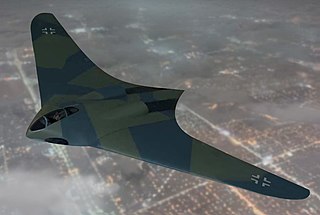
The Horten H.IX, RLM designation Ho 229 was a German prototype fighter/bomber initially designed by Reimar and Walter Horten to be built by Gothaer Waggonfabrik late in World War II. It was the first flying wing to be powered by jet engines.

The Horten H.IV was a German tailless flying wing glider in which the pilot was to lie in a prone position to reduce the frontal area, and hence drag. It was designed by Reimar and Walter Horten in Göttingen. Four were built between 1941 and 1943. They were flown in a number of unofficial competitions in Germany during World War II. After the war the flying examples were transported to the United Kingdom and the United States where several contest successes were achieved.
The FVA 1 Schwatze Düvel was a glider produced in Germany in 1920. It was a highly streamlined, thick winged cantilever monoplane.

The I.Ae. 34 Clen Antú, sometimes known as the Horten XVa after its designer Reimar Horten, was a two-seat tailless glider built in Argentina. Two single-seat variants competed unsuccessfully in the 1952 World Gliding Championships.

The I.Ae.41 Urubú was a two-seat flying wing tailless glider, built in Argentina by the Fábrica Militar de Aviones (FMA) in the 1950s.

The Horten H.III was a flying wing sailplane built by Walter and Reimar Horten in Germany from 1937 to 1944.
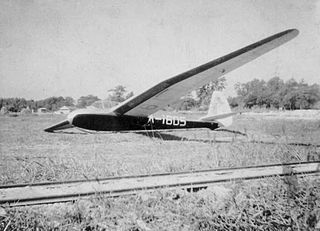
The Maeda 703 was one of the first indigenous Japanese gliders, a high performance single seat aircraft which first flew in 1940. Three were built, two with gull wing wings; one of these set a national endurance record in 1941.

The DFS Rhönsperber, otherwise known as the Schweyer Rhönsperber or Jacobs Rhönsperber was a single seat competition glider designed in Germany by Hans Jacobs and first flown in 1935. For several years it was regarded as the best German sailplane and about one hundred were built.

The DFS Reiher was a single seat competition glider designed in Germany by Hans Jacobs and first flown in 1937. The type won the last two German Rhön gliding championships before the start of World War II. Six were factory produced.
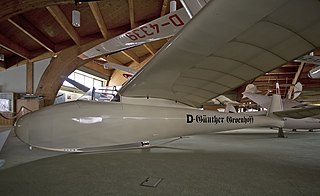
The Schleicher Rhönadler, DFS Rhönadler or Jacobs Rhönadler is a high performance, single seat competition sailplane built in Germany in the 1930s. More than 65 were built.
The Teichfuss Sparviero was an Italian single seat aerobatic glider, designed by Luigi Teichfuss and flown in 1938.

The RRG Fafnir, named after the legendary dragon, was a single seat German high performance glider designed by Alexander Lippisch. It won the Rhön competition in 1931 and made several outstanding flights as well as setting a fashion for gull wings.
The IIL IS-8 was a two-seat sailplane designed by Iosif Șilimon and built in Romania in 1960. They served with Romanian gliding clubs.
The Musger Mg 9 was a tandem two seat glider built in Austria in the mid-1930s. It broke both world and national records.

The Der Dessauer, later Der alte Dessauer, was a German single-seat glider built in the early 1920s. It took part in all the Rhön gliding contests on the Wasserkuppe between 1923 and 1928, flew in the Alps, and made a long-duration flight along the German sea shore.
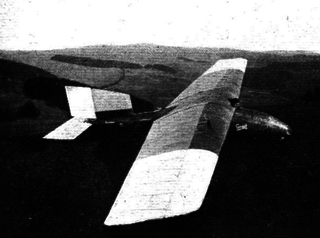
The Akaflieg Hannover H.2 Greif was a 1922 development of the successful Vampyr glider. Though it flew in three successive Rhön (Wasserkuppe) contests, it failed to match the achievements of its predecessor.
The Civil Aviation Department Ashvini was the first two-seat glider designed and built in India. It was produced in small numbers in the early 1960s.
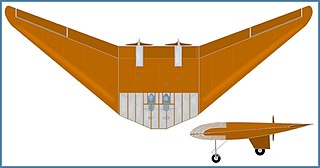
The Horten H.V was a delta-winged, tail-less, twin-engined motor-glider designed and built in the late 1930s and early 1940s by Walter and Reimar Horten in Germany. The H.V aircraft were used for various experimental duties, including: innovative structure, performance, stability and control of flying wing aircraft. The first H.V was the first aircraft to be built using an all composite material structure.

The PWS-101 was a high performance Polish glider first flown in 1937. One made the longest distance glider flight in Europe in 1938, gathering prizes for aircraft and pilot.
The Horten H.I was a German flying wing research glider built by Walter and Reimar Horten in 1933.















